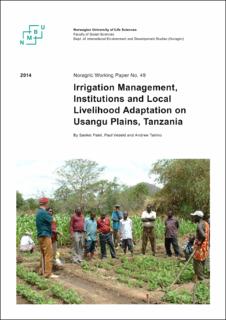| dc.contributor.author | Patel, Sanket | |
| dc.contributor.author | Vedeld, Paul | |
| dc.contributor.author | Tarimo, Andrew | |
| dc.coverage.spatial | Tanzania, Usangu | en_US |
| dc.date.accessioned | 2020-11-11T10:44:43Z | |
| dc.date.available | 2020-11-11T10:44:43Z | |
| dc.date.issued | 2014-10 | |
| dc.identifier.issn | 0809-4934 | |
| dc.identifier.uri | https://hdl.handle.net/11250/2687335 | |
| dc.description.abstract | This paper studies the evolution of irrigation water management in Usangu Plains and evaluates present irrigation schemes using Ostrom’s design principles for long-enduring common pool resources (CPR) and their influence on farmers’ livelihood. Three types of schemes were identified for comparative analysis. These types include traditional, improved and formally improved irrigation schemes. The results of a survey and participatory assessments using both qualitative and quantitative approaches reveal that household incomes are heavily agricultural based (90% income share) and largely determined by the availability of water, land and the access to other farm inputs. There are differences in farmers’ incomes in relation to schemes. We find that traditional scheme farmers are poorer. Improved management do depend on schemes’ ability to organise, the willingness to change, and how institutions are crafted in relation to their needs. Households in the schemes with high level of accordance with Ostrom’s design principles report better access to water and higher income security. Farmers’ perceptions of new and more formalised institutions are positive, but in practice, many still rely on traditional ways of organisation and interaction. We do not see that there is a consistent contradiction between formal and informal, embedded social institutions, but we think that institutional transformation is better described as an evolutionary process of change where they co-exist, partly as complimentary or overlapping entities but also partly in conflict over certain issues. Public policies and formal and informal institutional frameworks have evolved over time in rather un-coordinated and often contradicting manners. In future policy-making, more attention should be put on developing a more coherent institutional architecture where room is made for both formal organisation and institutions while still utilizing and emphasising local and informal existing social institutional attitudes, values and norms. | en_US |
| dc.language.iso | eng | en_US |
| dc.publisher | Norwegian University of Life Sciences, Ås | en_US |
| dc.relation.ispartofseries | Noragric Working Papers;49 | |
| dc.title | Irrigation Management, Institutions and Local Livelihood Adaptation on Usangu Plains, Tanzania | en_US |
| dc.type | Working paper | en_US |
| dc.subject.nsi | VDP::Social science: 200::Human geography: 290 | en_US |
| dc.source.pagenumber | 26 | en_US |
